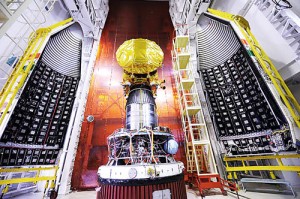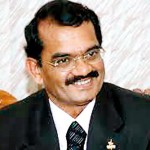Aiming for the Moon and the Sun
It’s interesting to note that the man who would take India to the Moon and later to Mars had never even travelled beyond his district in South India until he completed his Masters in 1982, aged 24. Mylswamy Annadurai would join the Indian Space Research Organisation (ISRO) that same year. Now it takes six levels of security clearance before you can talk to Annadurai, Programme Director for the Indian Remote Sensing, Science, Small Satellites Programme at ISRO.However, if all that effort didn’t appeal, you could have simply tracked down your quarry at the Zee Jaipur Literary Festival 2015 where Annadurai made an appearance on the panel ‘India: A Space Odyssey’.

Mangalyaan. Pic courtesy Indian Space Research Organisation
The extraordinary achievements of the Mangalyaan mission for which he served as Programme Director have been endlessly revisited in the months since India announced its success in September last year. That India was the first country to succeed on its first attempt; that the mission cost less than the budget of the film ‘Gravity’ and that the Tata Nano sized-craft would be used to test India’s ability to launch future interplanetary missions were all discussed excitedly – and sitting in front of me is the man who helped make it happen.
In person, Annadurai has a patient air, a luxuriant moustache and a thick South Indian accent. Before this, he was the programme director of India’s mission to the Moon. People asked him the same question they’re asking now. Why go where others have gone before you? “Look, [take] the Taj Mahal, so many people have seen it but still you would like to see. That is the lighter side,” he tells the Sunday Times, adding “Chandrayaan 1 was the 67th mission going to the moon, many people told ‘67 times people have gone to the moon, but why you have to go again?’You look at what happened there.”
India’s first lunar probe achieved what no other mission before it had – it identified the widespread prevalence of water in that alien soil. Science writer Pallava Bhagla who shared the stage with Annadurai at JLF explained how incredible this really was: “India’s Chandrayaan 1 changed our understanding of the Moon. The Americans spent billions of dollars on their mission…but it was left to India’s sub-million dollar mission to finally discover the presence of water molecules on the surface of the Moon.”Annadurai clarifies the point, explaining that Chandrayaan 1 established that the places where Neil Armstrong and his successors trod were indeed devoid of water – but it was present elsewhere.
This was in 2009 and clearly forgotten by those who questioned whether India had spent its funds wisely on the Mars Orbiter mission.So much of its populace was still deprived of essentials like sanitation, clean drinking water and electricity, they argued. (As if to underscore the irony, Annadurai’s own village of Kodhawady only received proper access to clean drinking water in 2013 – and likely only because his own high profile carried weight with local authorities.)
Not surprisingly, Indians are derisive of the notion that space exploration is solely the province of rich nations. Instead, many choose to see ISRO’s work as a rich vein of technology that can be mined for the benefit of a rapidly developing economy. Better communications, mapping and weather observation bring direct benefits to even the most vulnerable in society. Fishermen and farmers whose livelihoods are dictated by the vagaries of climate can testify to this. Few would contest that India’s improved meteorological capabilities have saved lives – the super cyclone that ravaged the coast of Orissa in 1999 claimed 10,000 lives, whereas the combined death toll from cyclones Phailin (2013)and Huhhud(2014) was just 50.

Mylswamy Annadurai
Annadurai is gently dismissive of claims that India’s success with Mangalyaan is unsustainable. It has been pointed out that the scientists working on the programme earn nowhere near as much as their NASA and ESA counterparts, and that they frequently work overtime. (As if to confirm this, Bhagla contends that some engineers slept at the ISRO Satellite Centre in Bangalore for the 18 months it took to build the craft – they went home, he said, only to change their clothes and do their pujas.)
However, Annadurai points to ISRO’s history of successful projects to argue that this is simply the way India works. “Our approach is different. Our manpower cost is less here, the way in which we develop technologies is different, of course we stretch a little more.” He argues that his scientists have lower living costs than those abroad – “so our salaries are good enough,” he says, describing an intense review process that places emphasis on teamwork and allows everyone a say.“People enjoy working here.”
That might actually be the truth; as Subhadra Menon who co-authored ‘Reaching for the Stars: India’s Journey to Mars and Beyond’ with Bhagla supported when she related her encounters with scientists who were passionate about helping realise India’s space ambitions.
“These people were not from the IITs or the Ivy League engineering colleges,” she says describing ISRO staff she spoke with. “They are from small town engineering colleges, they join ISRO as a first time job and they never leave.” In interviews they all spoke with pride of being able to contribute in even the smallest of ways to the success of a mission. “None of them spoke about salaries or monetary compensation, they said it was fine, they were happy.”
Annadurai himself seems to personify this ideal employee. Now, he says that they’re all busy analysing the data from Mangalyaan. The configurations of the instruments on board, and the planned orbit holds out possibilities for new discoveries and that they achieved this on their first try is perhaps most remarkable.“The first spacecraft that has gone to Mars was the fifth attempt by U.S, ninth attempt by Russia, China yet to make, Japan yet to make. This is the background in which we started our work.” But India’s approach was as simple as it was pragmatic: “Failure may be a stepping stone to victory, but it doesn’t mean you have to fail,” says Annadurai. “Many people have failed and you have the lessons learned from that.”
Their next goal is Aditya – a mission that will allow India to study the Sun. ISRO is also exploring the possibility of manned missions, perfecting the technology required to enable human beings not just to survive the gruelling journey to Mars, but to return. They even have an affordable budget of Rs. 12,500 crores pegged out (1 crore equals Rs 10 million) and say they could manage with seven years of preparation. All they need is the go-ahead to make history, once again.


